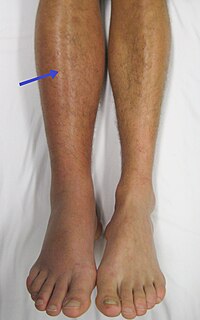
Photo from wikipedia
BACKGROUND Pulmonary edema may complicate the use of pulmonary arterial hypertension (PAH)-targeted therapies. We aimed to determine the proportion of patients who develop pulmonary edema after initiation of parenteral prostacyclin… Click to show full abstract
BACKGROUND Pulmonary edema may complicate the use of pulmonary arterial hypertension (PAH)-targeted therapies. We aimed to determine the proportion of patients who develop pulmonary edema after initiation of parenteral prostacyclin therapy, to identify its risk factors, and to assess its implications for hospital length of stay and mortality. METHODS A retrospective cohort study of patients with PAH at the initiation of parenteral prostacyclin between 1997 and 2015 enrolled in the Cleveland Clinic PAH registry. Pulmonary edema was defined as at least one symptom or clinical sign and radiographic evidence of pulmonary edema. We determined patient characteristics predictive of pulmonary edema as well as the association between pulmonary edema and hospital length of stay (LOS) and 6-month mortality. RESULTS One hundred and fifty-five patients were included (median age, 51 years; female, 72%; white, 85%; idiopathic, 64%; and connective tissue disease [CTD], 23%). Pulmonary edema developed in 33 of 155 patients (21%). Independent predictors of pulmonary edema were high right atrial pressure (RAP), CTD etiology, and the presence of three or more risk factors for left heart disease (LHD). Pulmonary edema was associated with a 4.5-day increase in hospital LOS (95% CI, 1.4-7.5 days; P < .001) and a 4-fold increase in 6-month mortality (OR, 4.3; 95% CI, 1.28-14.36; P = .031). CONCLUSIONS Pulmonary edema occurred in 21% of patients with PAH initiated on parenteral prostacyclin. Three or more risk factors for LHD, CTD-PAH, and a high baseline RAP were independent predictors of pulmonary edema. Pulmonary edema was associated with a prolonged hospital LOS and increased 6-month mortality.
Journal Title: Chest
Year Published: 2019
Link to full text (if available)
Share on Social Media: Sign Up to like & get
recommendations!